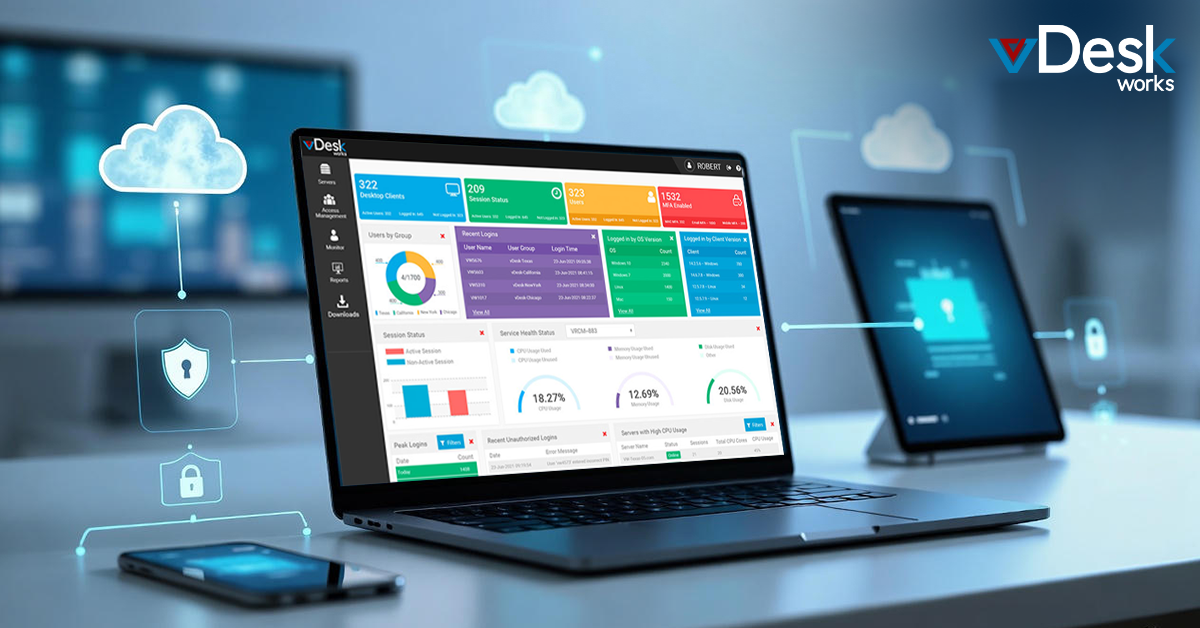Initially, VDI, led by Citrix, began with a single server hosting multiple sessions within MS OS2. Over time, the focus shifted to including remote applications to address user challenges.
Security gained prominence in VDI evolution, introducing conditional access solutions rooted in VPN technology. Users often adopt a do-it-yourself (DIY) approach, maintaining control over management, component selection, configuration, and maintenance. However, the landscape is changing with the growing influence of cloud requirements.
The blog explores the history of Virtual Desktop Infrastructure (VDI) and discusses three essential trends for budget considerations. The blog emphasizes three key trends in the VDI market – its historical trajectory, the crucial role of security, and the integration of cloud technologies. Understanding these trends is vital for the C-suite when making budget decisions in the dynamic VDI landscape.
What Impact Did This Transformation Have?
To simplify the technical details shared earlier, let's draw parallels with transformations we've witnessed daily. However, the music industry shifted from vinyl records, tapes, and CDs to a subscription-based streaming model accessible on any device. Similarly, the publishing world evolved from traditional bookstores to delivering content through streaming devices and audiobooks.
Cloud computing is a colossal and ever-expanding force reshaping our work dynamics. Instead of investing in an expensive, powerful PC and grappling with supply chain delays, a configured cloud PC empowers you to instantly create, upload, and edit high-quality videos from anywhere in the world, using any device.
Amitabh Sinha envisioned this paradigm shift over a decade ago, laying the foundation for Workspot. With many options emerging, the question is no longer about "if" such solutions will be available but rather about "when." Let's delve into three prominent trends steering the transformation from Virtual Desktop Infrastructure (VDI) to cloud PC solutions.
1. Cloud PC Emerges Victorious Over DIY VDI
The Do-It-Yourself (DIY) Virtual Desktop Infrastructure (VDI) era is fading away, with Cloud PC taking the lead. Recent revenue trends show DIY VDI facing challenges, and major players like Citrix and VMWare are transforming new ownership.
- Expect Changes in DIY VDI: DIY VDI is set for restructuring, likely leading to increased costs and a lack of innovation. Customers now have an opportunity to push existing cloud vendors and Cloud PC solutions to innovate and enhance their offerings.
- Unified Management with Cloud PC: Cloud PC provides a unified interface for managing hardware devices and virtual desktops. This streamlined approach allows IT departments to control remote devices and securely implement Bring-Your-Own-Device (BYOD) policies.
- Challenges in the "Great Resignation": The aftermath of the "Great Resignation" has left many devices with sensitive information unreturned to IT. Supply chain disruptions and semiconductor shortages add to the difficulties. A study suggests relief by 2024, emphasizing the need for more efficient onboarding processes.
- Google's Strategic Move: As a partner of Workspot, Google has the potential to redefine the market by positioning Chromebooks as secure enterprise devices. Integrating ChromeOS with Cloud PC creates a single interface for managing hardware and Software, making it an appealing option in the changing landscape.
2. Navigating Multicloud and Hybrid Needs: A User's Guide
Amidst recent acquisitions, Virtual Desktops present their native solutions leveraging its stronghold by imposing VDA and office virtualization fees. AWS Workspaces competes by integrating fees into its bundled offering.
- Google Cloud Takes a Partner-First Approach: Google Cloud stands out with a partner-first strategy, empowering customers to choose their preferred solutions. In a survey spanning North America, Europe, the Middle East, and Asia-Pacific, 90% of IT decision-makers favor a multi-cloud strategy.
- The Ongoing Role of On-Prem Data Centers: Many organizations still rely on on-premises data centers, making shifting to the cloud a gradual process. A flexible multi-cloud solution with hybrid capabilities becomes crucial for an efficient transition, supporting both cloud and on-premises requirements.
3. Safeguarding IT: Security and Ransomware Countermeasures
In IT essentials, security and ransomware mitigation take center stage. Cloud PC emerges as a key player, providing centralized security control. While multi-cloud management facilitates swift disaster recovery, ransomware poses unique challenges, demanding heightened attention from C-level executives.
- Ransomware on the Rise: According to Sophos' State of Ransomware study, ransomware attacks surged from 37% in 2020 to 66% in the last year. The manufacturing and production sector faced the highest average ransom payments, reaching $2.04 million. Recovery from a ransomware attack can extend to a month, underscoring the urgency for robust preventive measures.
- Innovative Mitigation Strategies Combatting ransomware requires innovative approaches. Isolated compute environments present an effective mitigation strategy, particularly when integrated with a cloud PC solution. This forward-looking strategy enhances security measures, providing a proactive defense against the evolving landscape of cybersecurity threats.
4. Flexibility in Action: Embracing Multicloud Solutions
As cloud landscapes evolve, users must navigate the complexities of multi-cloud and hybrid requirements. A Windows virtual desktop and workspace are pivotal players in this arena; with its VDA and office virtualization fees, it strategically bundles these costs into its offering.
- Survey Insights: A recent survey of 1,000 IT decision makers across regions revealed that 90% found a multi-cloud strategy effective for their enterprises. Given the diverse IT infrastructures, many organizations still maintain on-premises data centers. A flexible multi-cloud solution with hybrid capabilities is indispensable for seamlessly supporting cloud and on-premises requirements.
5. Transformative Potential: The Decline of DIY VDI
The do-it-yourself (DIY) VDI era is waning, if not obsolete. Cloud PC solutions are now at the forefront, reshaping the landscape. DIY VDI's revenue unit economics over the past six years depict a decline, with single digits from existing customers reluctant to undertake the labor-intensive lift and shift. Legacy VDI solutions, like Citrix and VMware, have undergone acquisitions, leading to anticipated price hikes, restructuring, and innovation gaps.
- Market Opportunity: The shift away from DIY VDI presents a ripe market opportunity. Organizations can challenge existing cloud vendors and cloud PC solutions to innovate, enhance value, and streamline business processes. The move towards consolidated control with single panes of glass for hardware devices and Cloud PCs signifies a pivotal transformation for IT departments, offering flexibility in remote device management and securely supporting the bring-your-own-device (BYOD) trend.
These trends underscore the dynamic shifts within the VDI virtual workspace, urging organizations to adapt and embrace innovative solutions for enhanced productivity, security, and business agility.
What's Next in VDI?
The future of Virtual Desktop Infrastructure (VDI) promises ongoing innovation as customers strategize to replace their Do-It-Yourself (DIY) VDI solutions. As organizations reevaluate their budget allocations, they can anticipate introducing new scalable options that align with evolving business needs.


 Emma Carson
Emma Carson
















